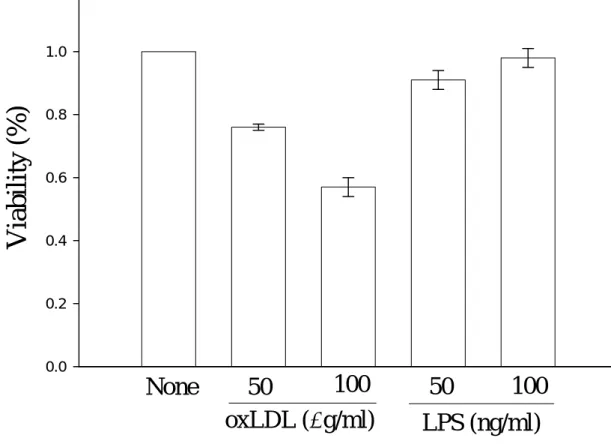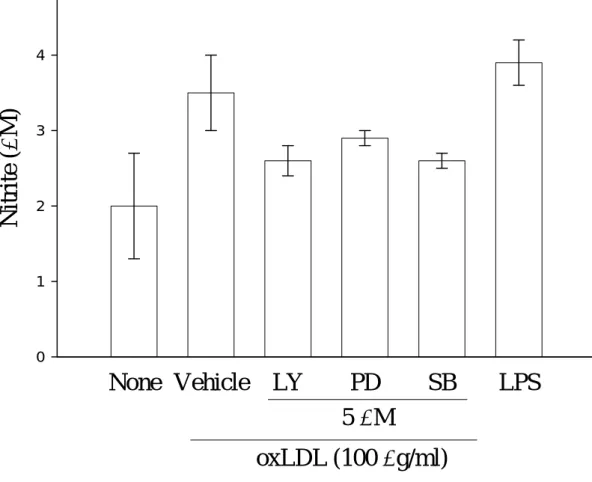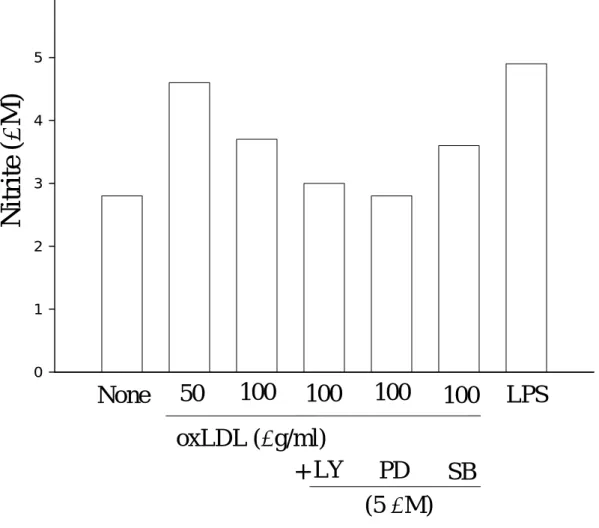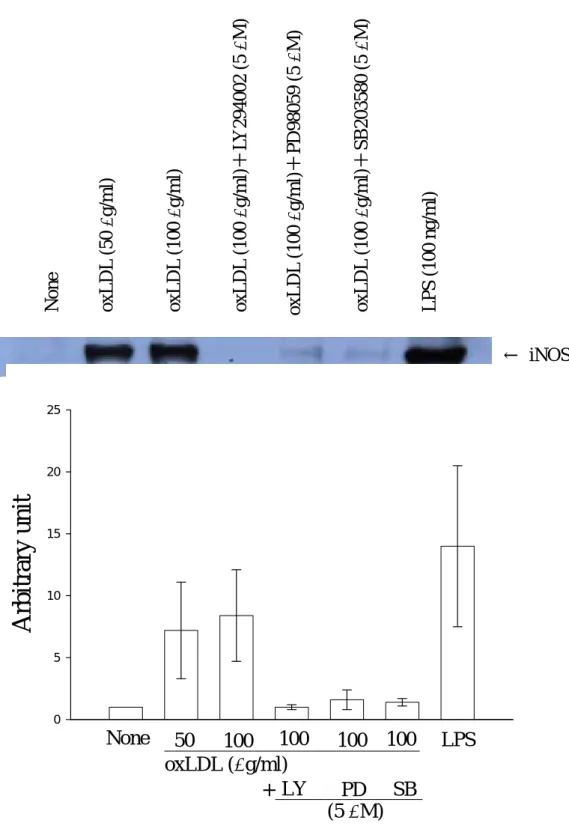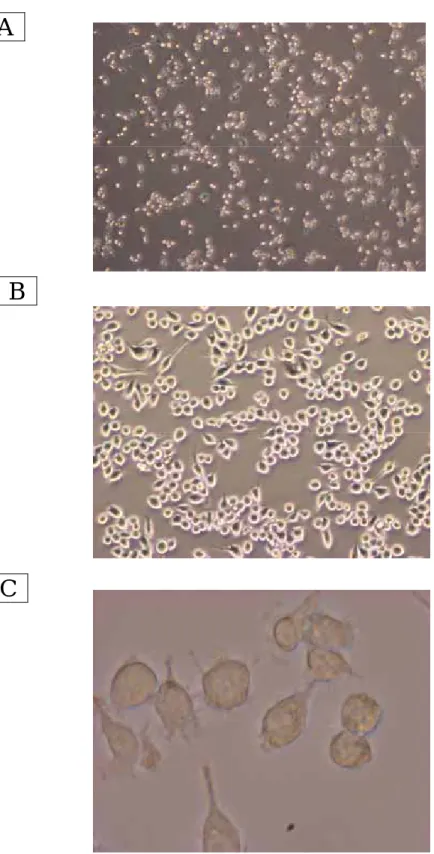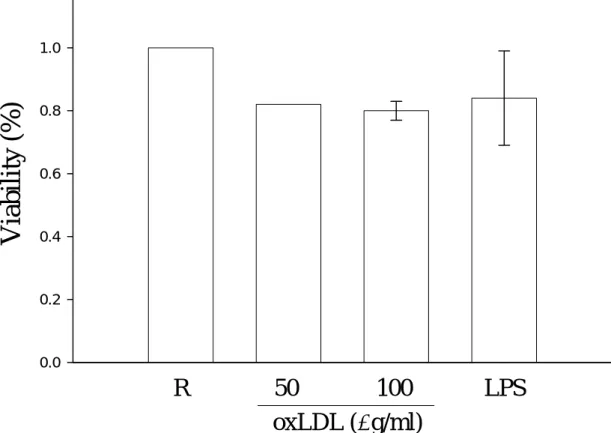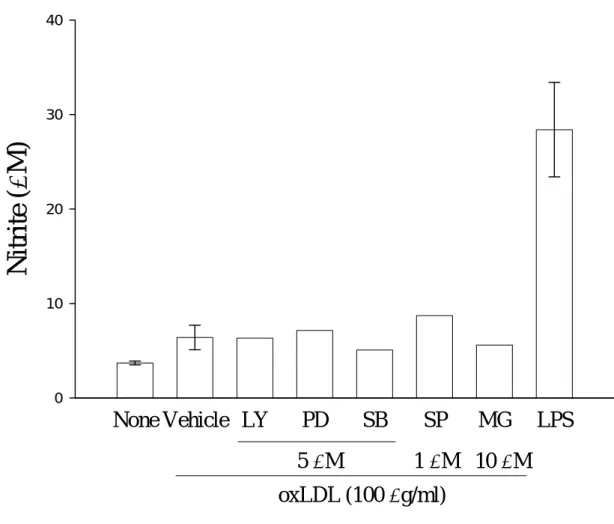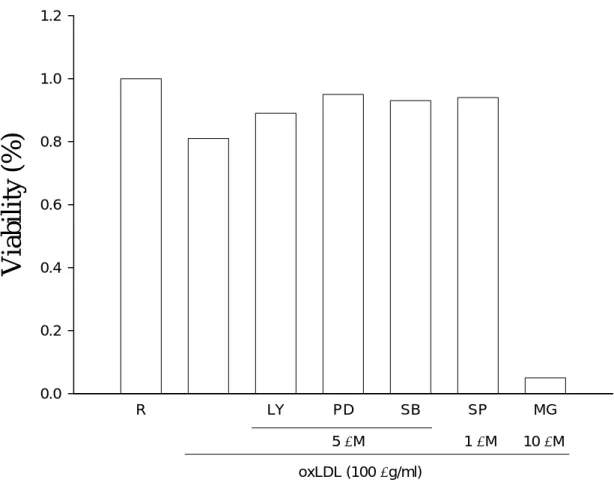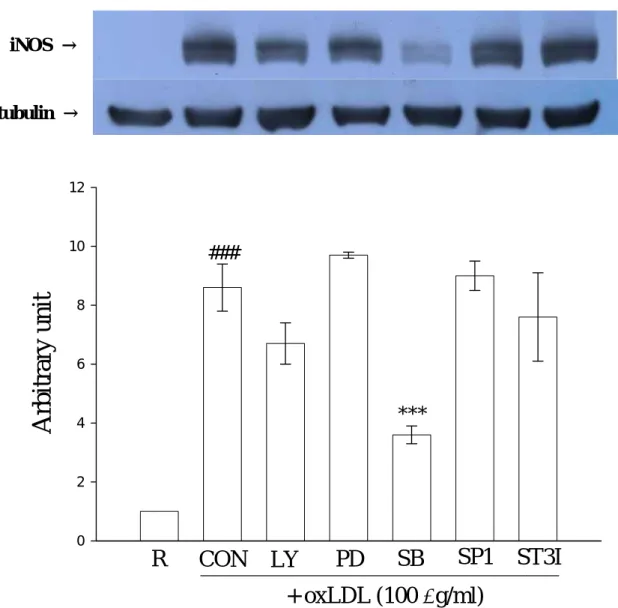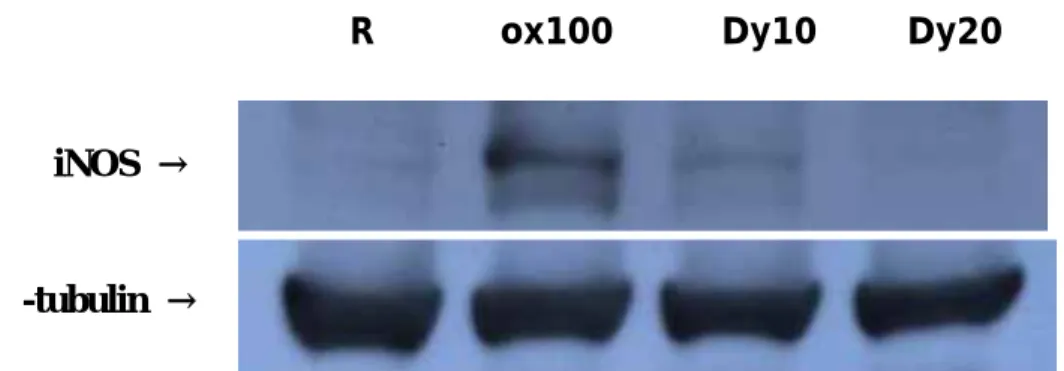行政院國家科學委員會專題研究計畫 期中進度報告
子計畫四:探討 JAK-STAT 在氧化態低密度脂蛋白活化小神經 膠細胞的訊息角色及不同氧化程度低密度脂蛋白引起與加
強腦中風傷害的差異性比較(2/3)
計畫類別: 整合型計畫
計畫編號: NSC94-2745-B-038-004-URD
執行期間: 94 年 08 月 01 日至 95 年 07 月 31 日 執行單位: 臺北醫學大學藥理學科
計畫主持人: 蕭哲志 共同主持人: 許重義
計畫參與人員: 蕭哲志, 林怡秀
報告類型: 精簡報告
處理方式: 本計畫可公開查詢
中 華 民 國 95 年 6 月 1 日
行政院國家科學委員會補助專題研究計畫 -期中進度報告
探討 JAK-STAT 在氧化態低密度脂蛋白活化小神經膠細胞的訊息角 色及不同氧化程度低密度脂蛋白引起與加強腦中風傷害的
差異性比較 (子計畫四) (2/3)
The studies of the role of JAK-STAT on oxidized low-density lipoprotein-induced microglia activation and comparison of the deleterious effects between different oxidative degree of low-density
lipoproteins on stroke (2/3)
計畫類別:整合型計畫
計畫編號:NSC 94-2745-B -038 -004-URD 執行期間:94 年 8 月 1 日至 95 年 7 月 31 日
計畫主持人:許重義教授校長 子計畫主持人:蕭哲志副教授 計畫參與人員:林怡秀博士生
成果報告類型(依經費核定清單規定繳交):精簡報告
本成果報告包括以下應繳交之附件:
□赴國外出差或研習心得報告一份
□赴大陸地區出差或研習心得報告一份
□出席國際學術會議心得報告及發表之論文各一份
□國際合作研究計畫國外研究報告書一份
處理方式:除產學合作研究計畫、提升產業技術及人才培育研究計
畫、列管計畫及下列情形者外,得立即公開查詢
□涉及專利或其他智慧財產權,□一年□二年後可公開查詢 執行單位:台北醫學大學醫學院藥理學研究所
中 華 民 國 95 年 5 月 30 日
一、中英文摘要
(IV) 探討 JAK-STAT 在氧化態低密度脂蛋白活化小神經膠細胞的訊 息角色及不同氧化程度低密度脂蛋白引起與加強腦中風傷害的差異
性比較
小神經膠細胞(microglia)在腦中風併發腦神經細胞損傷或髓鞘發 炎性損傷上扮演重要角色。另外根據文獻顯示氧化態低密度脂蛋白 (oxidized low density lipoprotein, oxLDL)藉著巨噬細胞(macrophage)之 清除性接受體攝入而引發特定細胞反應。此氧化態低密度脂蛋白不僅 對於內皮細胞具細胞致毒性,更可誘發慢性發炎反應。本計劃的主要 目地為探討氧化態低密度脂蛋白對腦中風相關發炎性傷害過程之影 響性,尤其探討氧化態低密度脂蛋白刺激小神經膠細胞表現一氧化氮 合成酵素(inducible nitric oxide synthase, iNOS)等之作用機轉,並進一 步比較不同來源與氧化程度的低密度脂蛋白之作用性,以了解其作用 之訊息機制。
本年度實驗室完成調整適當初級大鼠小神經膠細胞與細胞株 (BV-2)之分離與培養條件。從實驗結果發現人類氧化態低密度脂蛋白 對於初級或細胞株小神經膠細胞之作用,可明顯依濃度效應刺激一氧 化氮產生及一氧化氮合成酶之表現。藉著不同訊息相關抑制劑之實驗 結果顯示特定氧化之人類低密度脂蛋白刺激初級小神經膠細胞之訊 息可能藉由多重之路徑,而 BV-2 細胞主要藉由 p38 MAP kinase 路 徑,且 JAK-STATs 之訊息路徑較不重要。其中 oxLDL 活化 BV-2 細 胞過程中 endocytosis 在訊息進行具有重要角色。從這些結果可提供 氧化人類低密度脂蛋白對細胞之影響性,進而加速有關治療腦部發炎 退化性研究之進行。
關鍵詞:氧化態低密度脂蛋白、小神經膠細胞、誘發型一氧化氮合成 酶、訊息傳遞
(IV) The studies of the role of JAK-STAT on oxidized low-density lipoprotein-induced microglial activation and comparison of the deleterious effects between different oxidative degree of low-density lipoproteins on stroke
Activation of microglia is associated with the pathogenesis of neurodegenerative diseases. Oxidized low-density lipoprotein (oxLDL) is believed to play as a crucial role in the progression of inflammatory vasculopathies. Therefore, our studies were focused on the role of microglia in the oxLDL-associated stroke. Oxidized LDL is an activator of microglia for cytokines and nitric oxide production. Signaling may through its scavenger receptor, and activation of either Mitogen-activated protein kinases (MAP Kinases) or Janus kinase and signal transducer and activator of transcription (JAK-STAT) pathway in microglial cells.
According to our findings, non-dialyzed copper-catalyzed LDL could induce nitric oxide production and iNOS expression in primary and cell line (BV-2) microglia. It also have less cytotoxic to BV-2 as compare to primary microglia. The mechanism of nitric oxide synthase expression by copper-catalyzed oxidized LDL was supposed through endocytosis-mediated p38 MAPK pathway, however, JAK-STAT
pathway need more investigated.
Key words : oxidized LDL, microglia, inducible nitric oxide synthase, signal transductioncopper ion
二、源由與目的
當中樞神經系統受損時,小神經膠細胞會活化而作為第一道防禦 線 。 Microglia 在 腦 部 發 炎 病 變 中 會 活 化 成 巨 噬 細 胞 (cerebral macrophage) 執行吞噬功能,此時表面抗原像 Fc 及 CR3 受體會增 加,且伴隨快速誘導組織相容第一型及第二型抗原 (MHC class I & II antigens) 的新合成 (Streit et al., 1988)。活化過程包括細胞增生、增 加免疫表型、 microglia 補充到受傷區域 (Lindholm et al., 1992) 且功 能性改變,例如釋放 NO 等內生性物質或 cytokines 等發炎物質 (如 IL-1β, TNFα等) (Banati et al., 1993)。除此之外,microglia 有很強的 抗原表現和明顯的毒性作用。再者,microglia 的活化呈階段性反應;
如起初並沒有吞噬作用,過一段時間,特別是當神經或突觸末端退化 時,才會轉變成腦內的吞噬細胞 (Streit et al., 1988)。在許多發炎反應 或敗血症發生的過程中,microglia 會釋放好幾種 cytokines 包括 IL-1, IL-6, TNFα 和 TGFβ (transforming growth factor β)(Dickson et al., 1993)及一氧化氮 (NO) (Thery et al., 1991)。
小神經膠細胞在中樞神經系統發炎時會釋放出 NO 及 TNF-α。這 些 發 炎 介 質 已 被 證 實 與 發 炎 性 的 脫 髓 鞘 疾 病 (inflammatory demyelinating diseases) 如 多 發 性 硬 化 症 (multiple sclerosis) 等 有 關 (Parkinson et al., 1997)。氧化態低密度脂蛋白不僅對於內皮細胞具細 胞致毒性,更可誘發慢性發炎反應,且在不同腦部發炎性與退化性疾 病扮演相當重要之角色 (Newcombe et al., 1994; Emsley and Tyrrell, 2002)。近來文獻也提出 oxLDL 本身與急性冠狀動脈症及急性腦部梗 塞發作有相當之一致性 (Tsimikas et al., 2003; Uno et al., 2003)。特別 的是 oxLDL 會直接影響而降低冠狀動脈血流 (Laaksonen et al., 2002) 及直接造成實驗動物微血管通透度與白血球之沾黏性增高 (Svensjo et al., 2003)。
Mitogen-activated protein kinase (MAPKs)其訊息傳遞的路徑是經
由細胞膜進入核內,調控基因的表現(如:特定基因序列的產生、細 胞有絲分裂、增殖作用、代謝和細胞凋亡),其作用的活性會經由生 長因素或環境因素所影響,包括生長因子、紫外線照射、發炎性相關 的細胞激素和 stress。MAPKs 屬於 serine-theronine kinase 酵素,主要 的 MAPKs 為 extracellular signal-regulated kinase (ERK) 、 c-Jun N-terminal kinase (JNK)和 p38 kinase。而每ㄧ個 family 又由許多成員 所組成,例如: ERKs (ERK1 and ERK2)、JNKs (JNK1、JNK2 與 JNK3) 和 p38-MAPKs (p38-MAPKα 、 p38-MAPKβ 、 p38-MAPKγ 和 p38-MAPKδ) (Yang et al., 2003; Khan et al., 2004 and Wada and Penninger, 2004)。ㄧ般而言,一些生長因子會活化 ERK 的訊息傳遞 路徑,在細胞的增生則扮演了決定性的角色。而 JNK 和 p38 又稱 stress kinase,其傳導路徑會經由細胞本身或環境的刺激(如: change of metabolism 、 DNA damage 、 heat shock 、 ischemia 、 inflammatory cytokines、UV irradiation 和 oxidative stress)造成一種或多種 MAPK kinase (MKK)刺激 Thr 與 Tyr 的區域磷酸化而產生活性,進而轉移 (translocate)進入細胞核,促使轉錄因子(以 AP-1 為主)磷酸化,進而 啟動活化及基因表現(Baud and Karin, 2001 and Yang et al., 2003)。
Activator protein-1 簡稱 AP-1,也是屬於轉錄因子(transcription factors) 其中ㄧ個重要的成員,其組成包括 ATF (ATF2、LRF1/ATF3、B-ATF、
JDP1 與 JDP2)、Fos (c-Fos、FosB、Fra-1 與 Fra-2)、Jun (c-Jun、JunB 與 JunD)和 Maf (c-maf、MafA、MafB、MafG/F/K 與 Nrl),這些蛋白 質會去調控細胞的增生和凋亡(Peng, 2004)。在轉錄的過程中,AP-1 的活化會受到 MAPKs 的調控,尤其是 JNK 和 p38 都是最重要的調控 者,因為他們會使 c-Jun 磷酸化而產生活性,造成許多特定基因的表 現 (Yang et al., 2003)。因此,在免疫及發炎反應的過程中 AP-1 為扮 演一個重要的角色。
訊 息 活 化 轉 錄 因 子 (The signal transducer and activator of
transcription factors, STAT)一般被認為是生長因子或干擾素所活化而 啟動 DNA 轉錄的重要因子,但目前發現此訊息的活化可藉多種刺激 成分而達成。不同種類的 JAK 與 STAT 受不同訊號刺激而對應選擇性 活化 (Darnell et al., 1994; Zhang et al., 1995)。當相關接受體受活化 時 , 其 接 受 體 相 接 合 (associated) 的 JAKs (1/2/3) 便 會 磷 酸 化 (autophosphorylation),進而再活化相關 STAT (1/2/3/4/5)。此活化磷酸 化之 STAT 再轉位進入核內啟動基因表現 (Zhang et al., 1995) 此磷酸 化 之 STAT 可 受 去 磷 酸 酵 素 (Src homology 2 domain-containing protein phosphatase 2, SHP2) 所調控(Park et al., 2003)。近來發現腦部 特殊脂肪成份可藉由 JAK-STAT 訊息以誘發 microglia 合成釋放發炎 物質(NO 與 MCP-1) (Kim et al., 2002)。特別是 oxLDL 也藉其接受體 而刺激 microglia 引起吞噬與 ROS 之增加 (Newcombe et al., 1994;
Coraci et al., 2002)。
本計畫針對不同氧化處理的 ox-LDL 探討對 microglia 釋放 cytokines (如 IL-1β, TNFα等)或 NO 的差異性以及表現 inducible NO synthase (iNOS) 的作用機轉。本年度除報告之結果外,目前正進行 RT-PCR (m-RNA)之分析、Transient transfection and luciferase assay 、 EMSA 等相關實驗,以了解 p38 MAPK 路徑之重要性。也了解 JAK-STAT 之參與程度。透過本期與未來一年實驗,將有助於瞭解 ox-LDL 對中樞神經系統的 microglia 活化及腦缺血所引起的腦梗塞反 應所扮演的角色。經由這些研究可引領出一個新的治療方向,並期待 實驗成果可做為臨床治療的參考依據。
三、結果與討論
本年度研究延續第一年初級小神經膠細胞(rat microglial cell)之培 養與相關實驗,更增加mouse microglial cell line(BV-2)之培養與相關 實驗。實驗所使用之oxLDL主要為銅氧化之oxLDL (其條件為 5 µM
Cu2+,37℃處理 24 小時)。由Figure 1 顯示,此oxLDL對於此primary cell 具有濃度效應(50 與 100 µg/ml)相關之抑制存活之作用,相對於LPS (50 與 100 ng/ml)使用濃度範圍並無明顯之影響。以此oxLDL (100 µg/ml)刺激下的確會引起NO之生成,且約為未刺激者之 2 倍以上。
另一方面LPS作為正向對照組的確也可明顯刺激NO之生成。然而以 LY、PD及SB處理後,均可明顯抑制oxLDL所引起之NO生成(Figure 2)。此顯示oxLDL引發之訊息傳遞可能為Akt、ERK或p38 MAPK路 徑。特別的以空氣氧化生成之oxLDL,同樣也可引起小神經膠細胞產 生NO,然而以LY、PD及SB處理後,僅LY及PD具有抑制NO生成之作 用(Figure 3),此顯示air催化之oxLDL所引發之訊息路徑可能僅限於
Akt或ERK MAPK等。由Figure 4 顯示oxLDL的確可誘發初級小神經 膠細胞表現iNOS蛋白,且隨著濃度增加而提高iNOS表現量,相對的 正向對照組LPS也能誘發iNOS表現。特別的是LY294002、PD98059 及SB203580 均可明顯抑制此蛋白的表現,此結果符合Figure 2 對於 NO含量抑制之結果。此更可說明銅氧化之oxLDL可刺激大鼠初級小
神經膠細胞產生iNOS,其訊息路徑可能為Akt、ERK或p38 MAPK等。
由 Figure 5 顯示小神經膠細胞株(microglial cell line,BV-2)進行相 關實驗前之穩定培養及形態確認,此細胞屬半浮貼型細胞株,由不同 放大倍率可清楚分析其形態。以 oxLDL 不同濃度處理(50 與 100 µg/ml)
下,如同 LPS (50 ng/ml)一般並不引發 BV-2 細胞嚴重之傷害及減少存 活(Figure 6),此較初級細胞存活之影響為低(Figure 1)。同樣地以 oxLDL 隨濃度之增加(50 與 100 µg/ml)處理可明顯有意義地誘發 iNOS
表現,且達對照組之約 2-3 倍(Figure 7)。當以不同抑制劑間接探討其 訊息路徑時,NO 釋出量的確可受 oxLDL 所刺激產生,其中 LY、PD 與 SP 較無抑制作用,而以 SB 與 MG 具有抑制效果,此初步暗示其 訊息路徑可能為 p38 MAPK 或 NF-κB 路徑(Figure 8)。正向對照組 LPS
(50 ng/ml)所誘發 NO 之釋出量的確相當高。另一方面分析各抑制劑 否影響 BV-2 之存活率時,由實驗結果發現(Figure 9)多數使用之藥物
(LY、PD、SP 及 SB)並不影響 BV-2 之存活率,而僅 MG 卻會減低細 胞之存活率。進一步以 Western blot 方法分析 oxLDL 刺激 BV-2 表現 iNOS 是否也與不同抑制劑作用有一致性之結果。由 Figure 10 顯示以 oxLDL 刺激下,iNOS 表現約為 8.6±0.8 倍,其中以 SB 處理後有明顯 意義之抑制作用,其表現約為 3.6±0.3 倍。而其他抑制劑(LY、PD、
SP)並無明顯有意義之作用。由此可推斷 oxLDL 誘發 BV-2 產生 iNOS
主要藉由 p38 MAPK 路徑。特別的是 STAT-3 抑制劑也不具有抑制之 效果。此較初級細胞(primary microglial)有較高選擇之路徑(Figure
4)。另一方面,oxLDL 引發訊息之起始點除了 LOX 接受體外,是否 也藉 endocytosis 過程共同活化細胞訊息反應。實驗結果顯示特殊 Dy 抑制劑以濃度效應抑制 iNOS 之表現(Figure 11),此可初步說明 endocytosis 在 oxLDL 對細胞活化上具有重要之角色。針對 JAK-STAT 路徑,不同濃度 oxLDL (50 及 100 µg/ml)均無法明顯誘發 pSTAT1 或
pSTAT3 之表現,然而 interferon 的確可誘發兩者之表現(Figure 12)。
此結果與 Figure 10 之結果有一致性,也說明 JAK-STAT 路徑可能在 oxLDL 之訊息路徑上並不參與重要角色。
四、計畫成果自評
此研究計畫除了進行個人之子計畫實驗外,同時也指導其它子計 畫研究人員對於人類低密度脂蛋白之分離與氧化處理。本研究室設立 並確實改善初級細胞之(microglia)分離品質與培養進度,但此大鼠初 級細胞分離與培養成熟使用時間較長(需 9 天),又此腦部細胞並不增 殖分裂,所以每次進行實驗前必須犧牲大量初生大鼠以獲取細胞,實 驗進展上相當花費時間。本實驗室於今年 1 月中已獲得 BV-2 之細胞 株,其培養穩定也進行相關實驗,而加快實驗進度。藉由此一系列實 驗,我們清楚特定氧化 LDL 其對不同來源之 microglia 細胞均具有明 顯之誘發 iNOS 之作用,然而有關 NO 含量之變化仍需進一步分析或 改進測量方式。實驗有關 oxLDL 刺激細胞產生 iNOS 之作用與機轉 探討,目前正積極進行中,除了已確定 oxLDL 對於 BV-2 之訊息主要 在 p38 MAPK 路徑,而有關 JAK-STAT 路徑之參與程度,初步結果並 不符合原本之假設,但仍需進一步釐清研究。
Viability (%)
0.0 0.2 0.4 0.6 0.8 1.0 1.2
oxLDL (µg/ml) LPS (ng/ml) None 50 100 50 100
Figure 1. Effects of oxidized LDL on primary rat microglial cell viability.
Microglia (5 × 104 cells/ml/well) were treated with oxidized LDL (Cu++-catalyzed LDL, 50 or 100 µg/ml) for 22.5 hours, then added MTT to medium (final concentration, 0.5 mg/ml) to medium. After 1.5 hours, cells were washed and dissolved with DMSO. Using the spectrophotometric method by ELISA reader to analyze the absorbance at 550 nm. Percentage of cell viability was calculated as the absorbance of treated cells/control cells×100.
None Vehicle LY PD SB LPS
Nitrite ( µM)
0 1 2 3 4 5
oxLDL (100 µg/ml) 5 µM
Figure 2. Effect of various inhibitors on copper-catalyzed oxidized LDL-induced nitrite production in rat microglial cells. Microglia (5×104 cells/ml/well) were treated with vehicle or oxidized LDL (copper-catalyzed LDL at 37℃ for 24 h without dialyzation, 100 µg/ml) for 24 hr. Cell-free supernatant were assayed for nitrite production (Griess’s method). LPS (50 ng/ml) was added as positive control.
0 1 2 3 4 5 6
oxLDL (µg/ml)
(5 µM) SB 50
PD None
LY
100 100 100 100 LPS
+
Nitrite ( µM)
Figure 3. Effect of various inhibitors on air-catalyzed LDL-induced nitrite production in rat microglial cells. Microglia (5×104 cells/ml/well) were treated with oxidized LDL (Air-catalyzed LDL at 25℃ for 24 h without dialyzation, 50 or 100 µg/ml) for 24 hr. Cell-free supernatant were assayed for nitrite production (Griess’s method, µM). LPS (50 ng/ml) was added as positive control.
oxLDL (100 µg/ml) + L Y 294002 (5 µM) oxLDL (100 µg/ml) + S B 203580 (5 µM)
oxLDL (100 µg/ml) + P D 98059 (5 µM)
oxLDL (100 µg/ml)
oxLDL (50 µg/ml) LPS (100 ng/ml)
None
← iNOS
None
Arbitrary unit
0 5 10 15 20 25
oxLDL (µg/ml) LPS
LY
__________________________ 50 100 100 100 100 SB _______________ PD + (5 µM)
Figure 4 Effect of various inhibitors on oxidized LDL-induced nitrite production in rat microglial cells. Microglia (5×104 cells/ml/well, 5%
FBS) were treated with vehicle or oxidized LDL (Cu++-catalyzed LDL at 37℃ for 12 h without dialyzation, 50 or 100 µg/ml) for 24 hr. Cellular lysates were analyzed for iNOS expression. LPS (100 ng/ml) was
A
B
C
Figure 5. The morphology of BV-2 cells (microglial cell line). BV-2 cells (Panel A, B, C; X40, X100, X400) were observed. The collective cells were further cultured in RPMI-1640 supplemented with 10 % FBS. Cells (5×104 cells/ml) were then incubated with indicated oxidized LDL for activation.
R 50 100 LPS
Viability (%)
0.0 0.2 0.4 0.6 0.8 1.0 1.2
oxLDL (µg/ml)
Figure 6. Effects of copper-catalyzed oxidized LDL on BV-2 cell viability.
BV-2 cell (5 × 104 cells/ml/well) were treated with oxidized LDL (Cu++-catalyzed LDL, 50 or 100 µg/ml) for 22.5 hours, then added MTT to medium (final concentration, 0.5 mg/ml) to medium. After 1.5 hours, cells were washed and dissolved with DMSO. Using the spectrophotometric method by ELISA reader to analyze the absorbance at 550 nm. Percentage of cell viability was calculated as the absorbance of treated cells/control cells×100.
oxLDL (100 µg/ml)
oxLDL (50 µg/ml) LPS (100 ng/ml)
None
← iNOS
← α-tubulin
igure 7. Effect of oxidized LDL on iNOS expression in BV-2 cells. BV-2
1 2 3 4
Arbitrary unit *
0 2 4 6 8 10 12 14
___________ 50 100 LPS
oxLDL (µg/ml)*
F
cells (5×104 cells/ml/well) were treated with vehicle (Resting), oxidized LDL (Cu++-catalyzed LDL at 37℃ for 24 h without dialyzation, 50 or 100 µg/ml) for 24 hr. Cellular lysates were analyzed for iNOS expression.
LPS (100 ng/ml) was added as positive control. * P<0.05 as compared with the resting group.
None Vehicle LY PD SB SP MG LPS
N itrite ( µM)
0 10 20 30 40
oxLDL (100 µg/ml)
5 µM 1 µM 10 µM
Figure 8.Effect of various inhibitors on ai-catalyzed LDL-induced nitrite
s
production in BV-2 cells. BV-2 cell (5×104 cells/ml/well) were treated with vehicle or inhibitors (LY294002, PD98059, SB203580, SP60125, MG) for 15 min then stimulated by oxidized LDL (Cu++-catalyzed LDL, 100 µg/ml) for 24 hr. Cell-free supernatant were as ayed for nitrite production (Griess’s method). LPS (50 ng/ml) was added as positive control.
R LY PD SB SP MG
Viability (%)
0.0 0.2 0.4 0.6 0.8 1.0 1.2
oxLDL (100 µg/ml)
5 µM 1 µM 10 µM
Figure 9. Effects of various inhibitors and oxidized LDL on BV-2 cell viability. BV-2 cell (5×104 cells/ml/well) were treated with vehicle or inhibitors (LY294002, PD98059, SB203580, SP60125, MG) for 15 min then stimulated by oxidized LDL (Cu++-catalyzed LDL, 100 µg/ml) for 22.5 hours, then added MTT to medium (final concentration, 0.5 mg/ml) to medium. After 1.5 hours, cells were washed and dissolved with DMSO.
Using the spectrophotometric method by ELISA reader to analyze the absorbance at 550 nm. Percentage of cell viability was calculated as the absorbance of treated cells/control cells×100.
R ox100 LY5 PD5 SB5 SP1
iNOS →
R
Arbitrary unit
0 2 4 6 8 10 12
CON ________________________________ LY PD SB SP1 ST3I
###
***
+ oxLDL (100 µg/ml)
α-tubulin →
Figure 10. Effect of various inhibitors on copper-catalyzed LDL-induced iNOS expression. BV-2 (5×104 cells/ml/well) were treated with solvent control (0.1% DMSO) or various inhibitors (LY294002, PD98059, SB203580, SP60125, STAT3 inhibitor) for 15 min followed by the addition of oxidized LDL (Cu++-catalyzed LDL at 37℃ for 24 h without dialyzation, 100 µg/ml) for 24 hr. Cellular lysates were assayed for iNOS expression (n=3-6). ###
P<0.001 as compared with the resting group; ***
P<0.001 as compared with the control group.
R ox100 Dy10 Dy20
iNOS →
α-tubulin →
Figure 11. Effect of specific inhibitor on copper-catalyzed LDL-induced iNOS expression. BV-2 (5×104 cells/ml/well) were treated with solvent control (0.1% DMSO) or specific inhibitor (Dy, 10 and 20 µM) for 15 min followed by the addition of oxidized LDL (Cu++-catalyzed LDL at 37
℃ for 24 h without dialyzation, 100 µg/ml) for 24 hr. Cellular lysates were assayed for iNOS expression.
R ox50 ox100 LPS100 INF100U
91 kDa 84 kDa pSTAT1 →
→
86 kDa PSTAT3 →
Figure 12. Effect of oxidized LDL on pSTAT1 and pSTAT3 expression in BV-2 cells. BV-2 cells (5×104 cells/ml/well) were treated with vehicle (Resting), oxidized LDL (Cu++-catalyzed LDL at 37℃ for 24 h without dialyzation, 50 or 100 µg/ml) for 24 hr. Cellular lysates were analyzed for pSTAT1 or pSTAT3 expression. LPS (100 ng/ml) and interferon-α (100 u/ml) was added as positive control.
參考文獻
Banati, R.B., Gehrmann, J., Schubert, P. Kreutzberg, G.W. (1993) Cytotoxicity of microglia. Glia 7: 111-118.
Darnell, J.E., Jr, Kerr, I.M., Stark, G.R. (1994) Jak-STAT pathways and transcriptional activation in response to IFNs and other extracellular signaling proteins. Science. 264: 1415-1421.
Dickson, D.W., Lee, S.C., Mattiace, L.A., Yen, S.C., Brosnan, C. (1993) Microglia and cytokines in neurological disease with special reference to AIDS and Alzheimer’s disease. Glia 7: 75-83.
Emsley, H.C., Tyrrell, P.J. (2002) Inflammation and infection in clinical stroke. J. Cereb. Blood Flow Metab. 22: 1399-1419.
Kim, O.S., Park, E. J., Joe, E.H., Jou, I. (2002) JAK-STAT signaling mediates gangliosides-induced inflammatory responses in brain microglial cells. J.B.C. 277: 40594-40601.
Laaksonen, R., Janatuinen, T., Vesalainen, R., Lehtimaki, T., Elovaara, I., Jaakkola, O., Jokela, H., Laakso, J., Nuutila, P., Punnonen, K., Raitakari, O., Saikku, P., Salminen, K., Knuuti, J. (2002) High oxidized LDL and elevated plasma homocysteine contribute to the early reduction of myocardial flow reserve in healthy adults. Eur. J.
Clin. Invest. 32: 795-802.
Lindholm, D., Castren, E., Kiefer, R., Zafra, F., Thoenen, H. (1992) Tarnsforming growth factor-beta 1 in the rat brain: increase after injury and inhibition astrocyte proliferation. J. Cell Biol. 117:
395-400.
Newcombe, J., Li, H., Cuzner, M.L. (1994) Low density lipoprotein
for pathogenesis. Neutopathol Appl. Neurobiol. 20: 152-162.
Park, E.J., Park, S.Y., Joe, E., Jou, I. (2003) 15d-PGJ2 and rosiglitazone suppress janus kinase-STAT inflammatory signaling through induction of suppressor of cytokine signaling 1 (SOCS1) and SOCS3 in glia. The Journal of Biological Chemistry. 278: 14747-14752.
Parkinson, J.F., Mitrovic, B., Merrill, J.E. (1997) The role of nitric oxide in multiple sclerosis. J. Mol. Med. 75: 174-186.
Streit, W.J., Kreutzberg, G.W. (1988) Response of endogenous glial cells to motor neuron degeneration induced by toxic ricin. J. Comp.
Neurol. 268: 248-263.
Svensjo, E., Boschcov, P., Ketelhuth, D.F., Jancar, S., Gidlund, M. (2003) Increased microvascular permeability in the hamster cheek pouch induced by oxidized low fensity lipoprotein (oxLDL) and some fragmented apolipoprotein B proteins. Inflamm. Res. 52: 215-220.
Thery, C., Chamak, B., Mallat, M. (1991) Free radical killing of neurons, Eur. J. Neurosci. 3: 1155-1164.
Tsimikas, S., Bergmark, C., Beyer, R.W., Patel, R., Pattison, J., Miller, E., Juliano, J., Witztum, J.L. (2003) Temporal increases in plasma markers of oxidized low-density lipoprotein strongly reflect the presence of acute coronary syndromes. J. Am. Coll. Cardiol. 41:
360-370.
Uno, M., Kitazato, K.T., Nishi, K., Itabe, H., Nagahiro, S. (2003) Raised plasma oxidised LDL in acute cerebral infarction. J. Neurol.
Neurosurg. Psychiatry. 74: 312-316.
Zhang, X., Blenis, J., Li, H. (1995) Require ment of serine phosphorylation for formation of STAT-promoter complexes.
Science. 267: 1990-1994.
